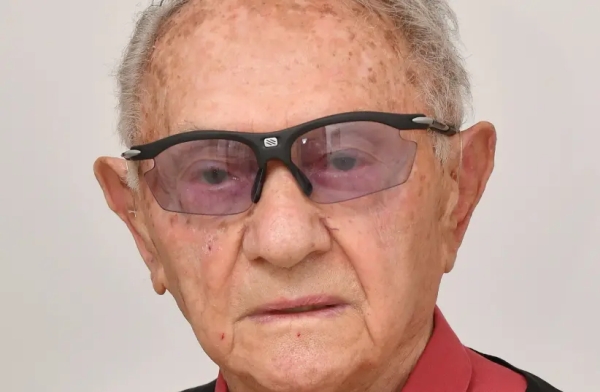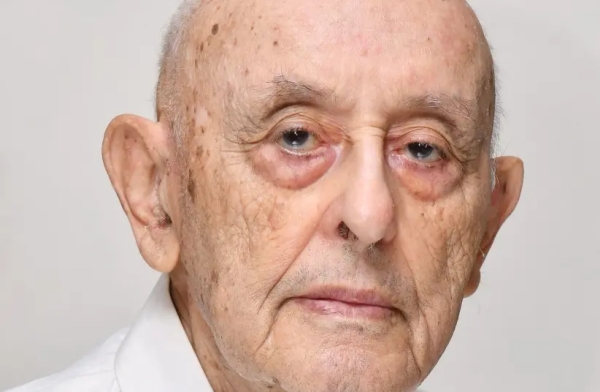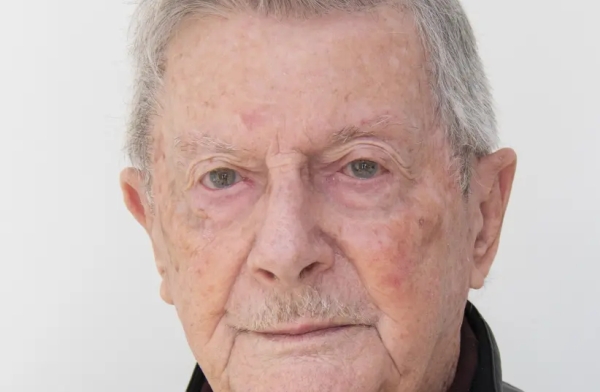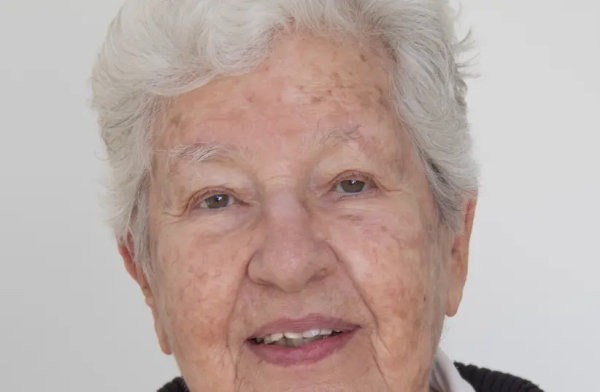
The Hall of Names at the Yad Vashem World Holocaust Remembrance Center
in Jerusalem, April 20, 2020.
(photo credit: Ronen Zvulun/Reuters)
The six torchlighters come from a range of backgrounds and experiences, but with one common theme: All of them suffered from the terrible deportations.

The annual opening ceremony at Yad Vashem marking Holocaust Martyrs' and Heroes' Remembrance Day would not be complete without the heart-wrenching testimonies of survivors telling of their personal journeys through the horrific years of the Holocaust.
Every year, six survivors light the traditional six torches, representing the six million Jews murdered by the Nazis and their collaborators.
The six torchlighters taking part in this year's ceremony on the evening of April 27, to be broadcast live on Yad Vashem's website, come from a range of backgrounds and experiences, but with one common theme: All of them suffered from the terrible deportations that are this year's central theme for Holocaust Remembrance Day.
Their stories will surely rekindle the flames of remembrance in each and every one of us.

Zvi Gill
Zvi Glazer (later Gill) was born in 1928 in Zduńska Wola, Poland, to Israel and Esther, wealthy ultra-Orthodox Jews. Zvi had two younger brothers, Arieh-Leib and Shmuel. In the spring of 1940, a ghetto was established in the city. In August 1942, with the liquidation of the ghetto, the Germans conducted a census in the city center. Zvi's father and brothers were taken to the gas trucks in Chelmno, and he was forcibly separated from his grandfather David.
As head nurse at the ghetto's hospital, Esther helped as many patients as possible to leave. She then walked to the gathering point wearing her Red Cross hat. Zvi and Esther were transported in cattle cars to the Lodz ghetto, where Zvi became a member of the Zionist youth movement. During the aktionen, Esther hid him behind a closet.
"I knew I was going to die. The question was not if, but when."
After the ghetto was liquidated, Zvi and Esther were deported to Auschwitz. He was transferred to forced labor in an aircraft repair factory, then to Dachau, and later to another camp in Germany, where he collapsed during a heavy snowstorm.
"An older German guard saved my life. He removed the wet clothes from me, dried them, and gave me a slice of bread with jam."
After recovering from typhus, Zvi was put on a train to an unknown destination. During the journey, air raid sirens sounded, and the prisoners were ordered to leave the carriages and lie on the ground. Zvi managed to escape, arriving at the home of a German farmer. He introduced himself as a Pole and worked on the farm in exchange for food and accommodation until liberation.
Zvi immigrated to Eretz Israel in 1945, and Esther joined him in 1947.
After fighting in the War of Independence, he became a writer, a senior journalist with the Israel Broadcasting Authority, and one of the founders of Israeli television. Zvi and Yehudit had three daughters, 10 grandchildren and three great-grandchildren.

Shmuel Blumenfeld
Shmuel Blumenfeld was born in 1926 in Krakow, Poland, to a family of rabbis and scribes. Soon after, his family of seven moved north to the town of Proszowice. Following the German occupation, Shmuel was sent to the nearby forced labor camp of Plaszow, where his father was murdered.
After witnessing an aktion in June 1942, Shmuel fled the 40 km. (25 miles) back to Proszowice. In August 1942, the town was surrounded. Encouraged by his mother, he escaped to the Krakow ghetto. In March 1943, the ghetto was liquidated and Shmuel was deported to Auschwitz, where he was selected to work in a coal mine.
On January 18, 1945, with the approach of the Red Army, Shmuel was forced on a death march with other prisoners. On reaching Buchenwald, he was sent to the Reimsdorf camp, where he cleared out bomb shrapnel and repaired roofs damaged by Allied bombings. In April 1945, Shmuel was sent on another death march – this time to the Terezin ghetto – and in May 1945, he was liberated by the Red Army.
After discovering his entire family had been killed, he began to help with the "Bericha" movement – the illegal immigration of Holocaust survivors to Western Europe on their way to Eretz Israel.
In 1948, Shmuel immigrated to Israel and enlisted in the IDF. Upon his release, he joined the prison service. During the trial of Adolf Eichmann, Shmuel was one of Eichmann's guards.
"I showed him the number on my arm and said, ‘You see? This is an authentic number. I was in Auschwitz for two years and I survived.'"
Shmuel is one of the founders of the Association for Proszowice Immigrants, and is active in commemorating the town's Jews who were lost in the Holocaust. Shmuel and Rivka have two children, six grandchildren and seven great-grandchildren.

Olga Kay
Olga Kay (nee Czik) was born in 1926 in the town of Ujfeherto, Hungary, the ninth of 10 siblings in an observant family. On April 15, 1944, the family was deported to the village of Simapuszta. A few weeks later, they were taken in cattle cars to Auschwitz. The journey lasted three days.
"When we were at the border my father said, ‘My beloved, we are going to die.' He took our jewelry and threw it in a bucket full of feces so the Germans would not find it."
Upon arrival in Auschwitz, most of the family was taken straight to the gas chambers. Olga and her sister Eva underwent a selection, and were sent to work in Auschwitz. In July 1944, they were taken to the Kaufering concentration camp in Germany, where she and other Jewish girls miraculously survived an air raid.
In November 1944, Olga and Eva were transferred to Bergen-Belsen. A month later, their sister Bella was deported there, and the three met.
"We were riddled with lice. We lay on the crowded floor. Death became commonplace. Today you, and tomorrow, whoever was next to me." They were liberated on 15 April 1945. "We did not jump for joy... I went to get food, but I was weak. I weighed 55 pounds."
Eva died soon after liberation. Olga and Bella were taken to Sweden to recuperate. From there they immigrated to New York, where Olga met her husband and started a family.
"When my daughter Evelyn was born, my first thought was, This is my victory over Hitler. We have returned from the ashes." In 1985, Olga and her family followed their daughter to live in Israel. Olga and George had two daughters, five grandchildren and 16 great-grandchildren.

Arie Shilansky
Arie Shilansky was born in 1928 in Siauliai, Lithuania, to a Zionist family, the youngest of four children. His father died soon after. With the German occupation of Lithuania, a ghetto was established in the town, and Arie's family was imprisoned there.
On November 5, 1943, the children's aktion began. On his sister's instruction, he fled to a warehouse, where the Jewish foreman hid him and other younger children behind a concealed door. Arie helped keep them quiet by telling them stories. When the adults found out that their children had been abducted, they cried out in anguish.
"That cry resonates within me to this day."
In July 1944, with the approach of the Red Army, the ghetto was evacuated and its prisoners sent west. Among them was Arie, who after several days of terrible overcrowding in a cattle car, arrived at the Stutthof concentration camp in northeastern Poland. Understanding that work meant a chance at survival, Arie managed to join a group of workers who were transported to one of the sub-camps of Dachau in Germany.
In early 1945, Arie was taken to the Landsberg camp, where he found his brother Dov. As the Allies approached, the prisoners were forced on a death march.
"We were led, in heavy snow, to spend the night between two mountains. SS men positioned themselves around us with machine guns. In the morning, we realized that they were gone. In the distance we heard loud noises. Americans. That was the moment of liberation."
After his release, Arie was reunited with his mother and sisters. He was taken to a hospital housed in the St. Ottilien Abbey in Germany. A delegation of the Jewish Brigade arrived at the monastery.
"That was a surprise. We did not believe that there were Jews left in the world. They promised that they would soon come again and take us to the Land of Israel. This goal gave us strength."
Some two weeks later, the brigade's soldiers transferred Arie to Italy. In February 1948, he immigrated to Eretz Israel and fought in the War of Independence. Arie and Ruth have three children, six grandchildren and five great-grandchildren.

Shaul Spielmann
Shaul Spielmann was born in 1931 in Vienna, Austria, an only child to Jossefa and Benno. The day after the Anschluss in March 1938, he and the two other Jewish students were banned from attending school. Two days later, SA officers broke into their apartment and threatened Shaul's life if his parents did not hand over all their valuables.
After the Germans confiscated the family's apartment and delicatessen, Shaul's family remained in Austria with his grandfather. In September 1942, they were taken to Terezin. About a year later, in November 1943, they were deported to Auschwitz. Jossefa became ill and was transferred to the Infirmary Block.
"I managed to move a wooden board and looked inside. She was a skeleton and could not get out of bed. One morning, her body was taken out on a cart."
Benno, who worked in the camp office as a registrar, moved Shaul's name to a list of older boys, thus saving him from death. Benno was then sent to another camp.
"I saw my father among the prisoners. He gestured with his fist: ‘Hold on.' That was the last time I saw him."
In August 1944, Shaul evaded death once more when the children's block overseer, Viennese by birth, argued that Shaul was essential for work. In January 1945, Shaul and the other prisoners were forced on a death march.
"We walked in forests, on paths strewn with corpses. At night, the prisoners lay on the floor in the frost; by morning, some had frozen to death."
Shaul was liberated by the US Army in Gunskirchen while suffering from typhus. After recovering, he immigrated to Eretz Israel and fought in all the Israeli wars until the Yom Kippur War. He worked in Magen David Adom in the Negev area, saving many lives and training the younger generations. Shaul and Myriam have seven children, 18 grandchildren and seven great-grandchildren.

Rebecca Elizur
Rebecca-Branca Lissauer (later Elizur) was born in 1934 in Amsterdam to Jack and Rosalie-Rachel. She had an older brother, Joop-Joshua. When Nazi Germany invaded the Netherlands in May 1940, Rebecca was in the first grade. The family was taken to the Westerbork transit camp, where, from the summer of 1942, deportation trains left weekly for the extermination camps in Eastern Europe.
"We stood by the trains and waved goodbye. The adults around me would cry because they knew that the passengers would never return."
A few months later, the Lissauer family was assigned to be exchanged for Germans held by the Western Allies. Instead of being sent to the East, they were deported to Bergen-Belsen, where the exchange candidates were concentrated. In the camp, Rebecca and her mother were separated from her father and brother.
"We suffered from terrible hunger. My mother kept faith even when she was very weak. She would encourage the other prisoners."
In April 1945, Rebecca and her family were taken by train to an unknown destination. During the journey, the train was bombed and the passengers jumped off the train and lay on the ground.
"Mother protected our heads with her hands and told us to repeat our names, the names of our parents and our dates of birth, in case she was killed." A few days later, the prisoners were liberated by the Red Army.
The family returned to Amsterdam, where Rebecca studied social work. In 1959, she immigrated to Israel and worked, among other endeavors, supporting Dutch immigrants. Rebecca and Dov have two daughters, nine grandchildren and five great-grandchildren.
 Life in Israel Articles
Life in Israel Articles
 Only in Israel
Only in Israel